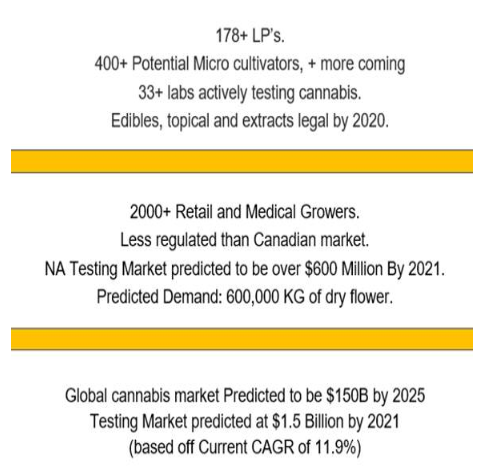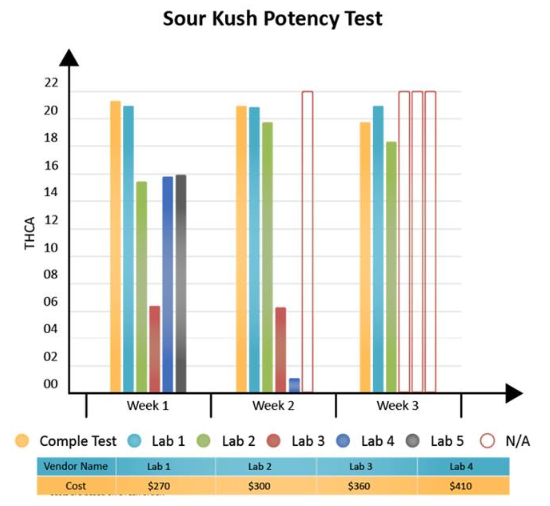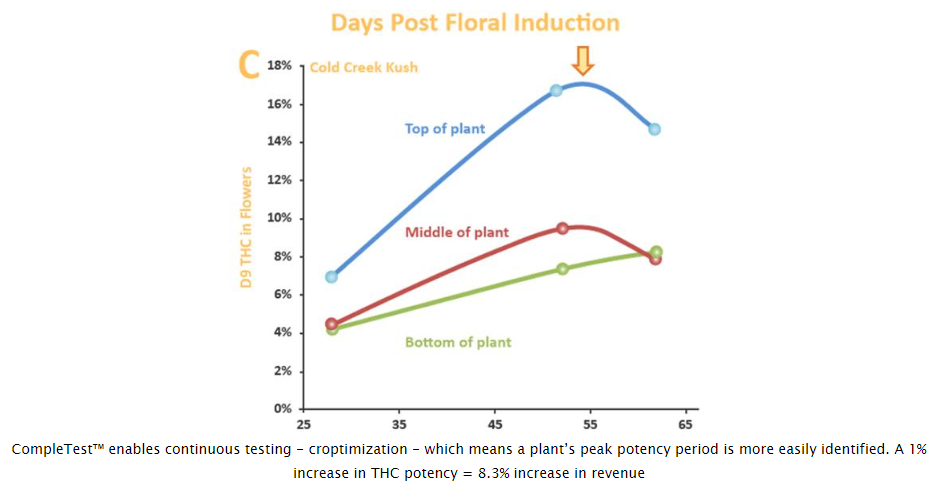
FluroTech provides
Licensed Producer’s rapid and effective inhouse cannabis
testing
As a general rule,
the most successful man in life is the man who has the best
information
Calgary, Alberta -- July 3, 2019 -- InvestorsHub
NewsWire -- (Source via: aheadoftheheard.com)
Imagine walking into your local liquor store to pick up a bottle of
wine. You have a few favorite varietals in mind, but you don’t
trust the alcohol percentages you see on the labels. Last week you
bought a Cabernet-Sauvignon from Chile, supposedly 14% alcohol by
volume (“ABV”), but it took three glasses to feel anything. The
week earlier though, another brand of Cab-Sauv from Chile
packed such a punch, you fell asleep after two glasses. Both
claimed to be 14% ABV. What gives?
Of course, this is
an imagined scenario; standardization of ABVs for all types of
alcohol has been in place since the end of Prohibition. Not so for
the burgeoning cannabis
industry.
Nine months into
legalization, the potency variability of both marijuana and hemp
plants is a problem associated with legalized cannabis in Canada
and half a dozen US
states.
Indeed the
“cross-variability” of a particular strain, or batch, is an
issue that affects everyone from the grower to the
consumer.
Canadian start-up
FluroTech (TSX-V:TEST) (OTCQB:FLURF) is offering a
solution to the problem. The Calgary-based Company has an extremely
accurate means of measuring both the strength of cannabis and its
purity - the latter referring to a product’s low or non-existent
levels of impurities like mold, pesticides and heavy
metals.
Need for
testing
Currently there is
no universal method for testing cannabis products. But as regulated
cannabis markets continue to emerge in North America (Canada and 11
US states now have legal marijuana, sold for medicinal and
recreational purposes), there is a growing need for a system of
rapid and effective cannabis
testing.
The testing market
is pegged at $300 million in Canada - just over double that as
compared to the United States - and $2.75 billion
worldwide.
FluroTech is
the first mover in this space with portable spectroscopy analytical
testing
devices.

The testing device, called CompleTest™, uses
spectroscopy and fluorescence to measure the content of a given
attribute including CBDA and THCA, which are the acid forms of THC
and CBD present in cannabis plants before combustion or
vaporization. The Company will be releasing a test for mold,
pesticides and heavy metals as well as THC and CBD for extracts and
processed products. The device has been
commercialized.
TEST’s revenue model
involves selling testing devices to licensed cultivator’s cannabis
producers, retailers, extractors and companies that do drug
testing. The buyer would purchase a testing device plus a
“scope” that slots into the device for each type of test –
THCA/CBDA, pesticides, heavy metals, etc. Each test or assay (“lab
kit”) would be priced individually or bundled per
month.
The Company is also
pursuing the use of CompleTest™ in workplace testing, law
enforcement, the hemp market for CBD products, and “biomarking” -
whereby a compound is placed into every plant grown by a licensed
producer (“LP”) that can be tracked throughout the plant’s life,
all the way from processing to the end product that is
consumed.
Of great interest to
the dispensary and consumer is the THC level in cannabis. Or, in
the case of CBD products, the amount of cannabidiol. Some cannabis
consumers want high THC content in their bud, while others prefer
something less potent. This is mirrored with buyers of CBD
products.
But early testing
has its advantages far before the final test for potency is
conducted on the strain that is distributed to
dispensaries.
Unlike getting a sample tested in a standard, third
party lab, CompleTest™ can return a result within minutes -
versus days or weeks. This is a big advantage to cannabis growers
because it vastly reduces wait times. It also allows growers to
test plants at any time during the growth cycle instead of only at
the final stage when the product must be tested to meet government
regulations before being sold.
Frequent, regular
testing enables growers to identify pests or contaminants (heavy
metals, insecticides, herbicides, mold), early on, and to optimize
their crops, making them more profitable. It also gives consumers
more confidence that the company they are buying from, delivers a
quality, contaminant-free product that also offers consistent
dosing (potency). The worst kind of publicity for an LP is the
discovery of a tainted crop that has to be pulled from
shelves.
The need for testing
has become even more relevant in Canada's run-up to the
legalization of cannabis edibles in December. The new regulations
will include inhalable extracts, foods, beverages and topical
applications like lotions. Ottawa is reportedly restricting
the potency of edibles to 10 milligrams of THC -
the low limit has invited criticism from those who say it won’t do
away with the black market, where pot-infused foods can contain up
to 80 mg.
THC.
Over-precaution
aside, the edibles market is large enough to make an LP salivate.
According to a report from BDS
Analytics, North American consumers spent $1
billion USD on edibles in 2017. The market is expected to grow to
$4.1 billion USD by
2022.
Cross-variability; an industry problem
As previously
mentioned, the current state of cannabis testing is unreliable,
with different testing laboratories failing to produce consistent
results. Even if labs use the same technology (e.g.
high-performance liquid chromatography (HPLC)), which separates and
evaluates a mix of chemicals in a liquid solution - the results can
vary wildly, discrediting the cannabis testing sector.
The same batch of
cannabis tested by different test labs will also produce
significant variability. Labs have various protocols and
calibration techniques, resulting in different recorded
potencies.
Consider a study
done by the Washington Cannabis Farmers Council. A cannabis sample
was sent to eight labs in the state, which legalized recreational
weed in 2012. The THC potency results varied from 13.37% on the low side to a
high of 26.9% - showing a variability
of approximately 100%!

The cannabis
industry is well aware of the problems with HPLC testing.
“There are a
tremendous number of questions around the reliability of the data
that’s being generated by cannabis laboratories,” said Jeremy Applen, owner of New Mexico’s
first state-approved testing laboratory.
“If you don’t have
robust standards around cultivation, manufacturing, or
distribution, you don’t really know what chain of events occurred
prior to that product being identified as potentially
adulterated.”
Therefore, as the
cannabis industry continues to grow, with more and more states
legalizing and even the US federal government mulling it, there is
an increasing demand for testing labs to perform potency, safety
and quality tests on ever-increasing quantities of
product.
To do that, the
industry will need to come up with more reliable testing methods,
regulations and standards. And solve the cross-variability
puzzle.
There are several
aspects to the problem, which we will aim to summarize
here.
The first thing to
understand is that the plant being tested is not in itself
homogenous. That means when cannabinoids are extracted into a
liquid for analysis, it’s difficult to find a batch where all the
ingredients are the same. For example, the trichomes - small
hair-like crystals on the marijuana bud - may be distributed
differently from one batch to another.
Second, while
Health Canada-approved labs may use the same HPLC technology and
instrumentation, their testing methods may differ, producing
different results.
And third, there
may be variation between testers, with some employees of test labs
lacking training or experience or the testing equipment may not be
used properly. The old saying “garbage in, garbage out” is relevant
here.
The end
result is the plant sample sent by the grower may come back
with an unexpectedly high or low level of THCA or CBDA, which can
be frustrating to the grower, especially since standard wait times
for results range from a week to 10 days. It may even result in a
crop being destroyed other case of finding contaminants, at great
expense to the grower.
Another issue
present is variable “cannabinoid standards”. In Canada, when a new
lab wants to get certified by Health Canada to conduct cannabis
testing, it must first go to a certified lab to obtain standards of
testing, such as how high of a concentration they are allowed to
test (e.g. 1 mg/mL). The new lab will then develop its own method
of testing based on the certified lab’s cannabinoid standards.
Different labs use standards that differ slightly in concentration,
thereby allowing for variability in test results as compared to
other labs.
Then there are the
problems with the labs themselves. Forbes mentions
this in an article where it pithily headlines
‘Cannabis lab testing is the industry’s dirty little secret’. In
the United States this means that “not all labs are created equal”,
meaning that some labs are more “industry-friendly” than others, by
rejecting few batches. This is facilitated by a lack of government
oversight. Forbes states:
The labs
themselves aren't inspected or graded by any agencies and customers
have no idea whether or not products were tested at a
reputable lab.
Some believe
that the problem is standardization, but there are plenty of state
standards -- the real problem is
enforcement.
Marijuana with a
higher THC content is generally considered by consumers to be of
higher quality, therefore it commands a higher price. This can
affect how a batch is tested. The higher price incentivizes growers
to produce marijuana with more THCA, and some unscrupulous labs can
help the grower to achieve its goal. Or, an unethical LP could send
in another batch for testing, higher in THCA, than its own, without
the lab knowing it.
Tightening
up the math
As a first mover
in the cannabis testing space with a disruptive testing
technology, FluroTech has taken it upon themselves to run
a battery of tests in order to show cross-variability and the
consistency/ repeatability of its testing
protocol.
The company has
gone out to multiple LP’s and tested, so far, about 60 marijuana
strains. It ran the tests internally using several testers on
different CompleTest™ machines. FluroTech also sent
its samples to an outside lab to confirm the results were the same
as the “listing” (potency) of that particular
strain.
“Rather than just
relying on the standard that came in we run a test the same way
every time, we double check by looking to outside sources, and by
comparing different producers to different producers' listings,
we're tightening up our math,” says FluroTech COO Rex
Kary.
Cross-variability
experiment
The company also
compared its own internal testing to that of third-party
laboratories. TEST first obtained two marijuana samples from a
dispensary. It divided the samples into ground-up plant material,
the whole flower/bud, and an extract. Those samples were then sent
to five different labs, which measured the potency (THCA and CBDA)
of the samples according to their testing
methodology.

FluroTech ran
its own in-house testing of the samples then compared the results
to those of the five third-party labs. It expected to prove both
cross-lab variability and the better accuracy of its own testing.
The Company was also hoping to prove that its results are
repeatable, by comparing samples tested
at FluroTech’s facilities over the course of several
weeks. The results (above) speak for themselves – besides being
cheaper FluroTech’s CompleTest™ was faster as it’s done
in house in a matter of minutes and showed superior consistency
between tests.
Earlier, a THCA
standard tested 25 times by CompleTestTM showed the
device’s capability of delivering the same results time and again,
with very low variance. The ability to replicate results provides
LP’s the ability to know the potency and purity of their product
before harvesting.

Low
barrier to entry
As a
company, FluroTech isn’t only about the science behind
cannabis testing; while the lab techs pour over samples and test
results, its sales team is taking CompleTest™ on the
road.
FluroTech’s beta program involves leaving
several CompleTest™ units at LP’s for them to try out. The
hope is for all of those “betas” to convert into sales. The sales
territory begins in Western Canada, to be followed by a pivot to
Eastern Canada, before spreading stateside for hemp testing - and
even into the Caribbean.
Good old-fashioned
networking has proved fruitful. The sales team has attended all the
major conventions, including the recent C-45 Quality Summit in
Winnipeg. They won best new technology at a Vancouver conference in
January debuting the testing device.
“Most people in
the industry already have a fairly strong understanding of the
problems within cross-lab variability, so it’s very refreshing for
them to hear something so accurate like our machine can be brought
into their facility,” said Zack Kary.
“The ability to
test plants throughout the growth cycle is also well received. This
gives them the ability to really rein in on the exact point of
harvest that would benefit them. So, keeping the highest potency,
not wasting any energy on nutrients, water, light, that sort of
thing, and just optimizing crops. That’s the main thing I've been
seeing LPs get really excited about.”
Eric
Entz said while talking to LPs, informing
them of CompleTest™’s ability to reduce bottlenecks, time
constraints and loads on QA staff, “it’s not even a matter of
sales”, meaning the conversation is more about filling a
need:
“It’s very low
barrier to entry in terms of getting in with these LPs because they
all, like Zach said, understand it. They say it’s lab one versus
lab two,” in terms of getting variable
results.
He noted that some
LPs tell him a 1% bump in plant potency represents a 9% increase in
revenue from that crop. “So, when they hear that what we have can
save them time, money, and effort, well, it’s very simple.”
Matt
Gibson chose consistency of results as an
important attribute of CompleTest™ that LPs are looking for:
“To be able to have that in your own hands gives you as a LP much
more confidence in the product that you’re going to eventually
sell.”

Finally, Mauricio Airias, who leads
the FluroTech team of R&D
scientists, noted the flexibility of having a simple to operate
testing instrument in-house, that can quickly test several samples,
in different growing periods and conditions, without reliance on an
outside lab, is a real game-changer for growers he has spoken
with.
“It is perfect for
them to have something on hand that is easily available that pretty
much any person with limited training can start using the equipment
and get reproducible and accurate data. I think that's the most
important aspect of the instrument.”
Of course, cost
saving is a key part of the value proposition. Out of a 55 to 60
day grow cycle, having an in-house testing device and testing
protocol can potentially knock five days off the harvest cycle.
That can significantly cut a producer’s costs, because they are not
wasting nutrients, electricity, or taking up space in their grow
room with plants that could be harvested.
Conclusion
FluroTech (TSX-V:TEST) (OTCQB:FLURF) has a disruptive
testing technology, CompleTest™, with the ability to transform
the cannabis sector, through a marked improvement in the
reliability and repeatability of cannabis testing. If successful,
the Company could be the first to create a standardized testing
regime for marijuana and hemp plant material, that could one day
equal the alcohol industry.
I am following
developments at TEST with interest as it continues to prove its
game-changing technology in a blooming industry that appears to be
the perfect fit.
FluroTech
TSX-V:TEST, OTCQB:FLURF
Cdn$0.35 June
28th
Shares Outstanding
54.2m
Market cap
Cdn$18.9m
FluroTech website
*****
Richard (Rick)
Mills
subscribe to my free
newsletter
aheadoftheherd.com
Ahead of the Herd Twitter
Ahead of the Herd FaceBook
Legal
Notice / Disclaimer
This document is
not and should not be construed as an offer to sell or the
solicitation of an offer to purchase or subscribe for any
investment. Richard Mills has based this document on information
obtained from sources he believes to be reliable but
which has not been independently verified. Richard Mills makes no
guarantee, representation or warranty and accepts no responsibility
or liability as
to its accuracy or
completeness. Expressions of opinion are those of Richard Mills
only and are subject to change without notice. Richard Mills
assumes no warranty, liability or guarantee for the current
relevance, correctness or completeness of any information provided
within this Report and will not be held liable for the consequence
of reliance upon any opinion or statement contained herein or any
omission. Furthermore, I, Richard Mills, assume no liability for
any direct or indirect loss or damage or, in particular,
for lost profit, which you may incur as a result of the use
and existence of the information provided within this
Report.
Richard does not
own shares of FluroTech (TSX.V:TEST). TEST is an advertiser on
Richards site,
aheadoftheherd.com
Source via:
aheadoftheheard.com